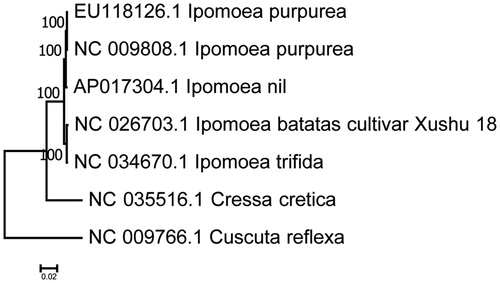Abstract
Ipomoea trifida is a herbaceous plant of the family Convolvulaceae that is mainly distributed around the Caribbean Sea. In this study, we reported and analyzed the complete chloroplast genome of I. trifida. It was 161,133 bp in length containing a pair of 27,297 bp inverted repeat regions (IRs) separated by one large and one small single copy region (SSC and LSC) of 88,107 bp and 18,432 bp, respectively. The phylogenetic tree shows that I. trifida forms a clade with the species of I. batatas, and sister to other Ipomoea species.
Ipomoea trifida (Kunth) G. Don is a herbaceous plant of the family Convolvulaceae that is mainly distributed around the Caribbean Sea. It is the wild relative of sweet potato that boasts of stress resistance genes in its genome with great potential for cultivated sweet potato (I. batatas (L.) Lam) breeding (Freyre Citation1991). However, its narrow and fragmented habitats distribution and sporophytic self-sterility traits during the flowering phase, together with the climate changes in recent years, have markedly shrunk its wild populations and threatened its germplasm utilization. To protect and make use of the germplasm resources are needed urgently. Genome information becomes necessary for its effective management and conservation. It is quite urgent to develop highly variable DNA markers for population study and germplasm utilization of I. trifida.
Chloroplast genome sequences are of great value in plant phylogenetic, conservation genetics, and population genetic studies. In the genus Ipomoea L., so far only three chloroplast genomes have been sequenced: I. batatas (cultivated sweet potato; NC_026703) (Yan et al. Citation2015), I. purpurea (common morning-glory; EU118126) (McNeal et al. Citation2007), and I. nil (Japanese morning glory; AP017304) (Hoshino et al. Citation2016). In this study, we determined the complete chloroplast genome sequence of I. trifida (GenBank accession number: KY596675) and added a new record of reported chloroplast genome to the family Convolvulaceae. The DNA was isolated from leaves of this plant and the plant material and isolated DNA are conserved in the College of Marine Science and Biological Engineering, Qingdao University of Science and Technology, Qingdao, China. After genome sequencing, the total DNA sequencing reads were first subjected to NCBI-blast, version 2.2.31+ (ftp://ftp.ncbi.nih.gov/blast/) to screen out chloroplast DNA reads with a reference data set containing all the sequenced angiosperm chloroplast genomes (ftp://ftp.ncbi.nlm.nih.gov/refseq/release/plastid/), and then the filtered reads were assembled by using ABySS version 1.9.0 (Simpson et al. Citation2009). The complete chloroplast genome was annotated with Dual Organellar Genome Annotator (DOGMA; Wyman et al. Citation2004) and submitted with Sequin (http://www.ncbi.nlm.nih.gov/). A physical map of the chloroplast genome was generated by OGDRAW (http://ogdraw.mpimp-golm.mpg.de/) (Lohse et al. Citation2013).
The complete chloroplast genome of I. trifida was a double-stranded circular DNA with 161,133 bp in length. Its quadripartite structure was composed of two inverted repeated regions (IRa and IRb) of 27,297 bp separated by a large single-copy (SSC) region of 88,107 bp and a small single-copy (LSC) region of 18,432 bp. The genome organization, gene content and genes’ relative positions of its 113 individual genes (79 protein-encoding genes, 30 tRNA genes, and 4 rRNA genes) were identical to those of the other three reported Ipomoea chloroplast genomes. Genome-wide sequence variations were examined among four Ipomoea chloroplast genomes. Although the chloroplast genome was largely conserved, several sequence variations were found in the regions of the psbA, psbD, psaB, psaA, and ycf1 genes, which will help develop variable DNA markers for further population studies of I. trifida.
To validate the phylogenetic relationships of I. trifida in the Convolvulaceae, we constructed a maximum likelihood tree using seven Convolvulaceae taxa. Phylogenetic analysis was performed on complete genome sequence using RAxML (Stamatakis et al. Citation2008). The resulting tree shows that I. trifida forms a clade with the species of I. batatas, and sister to other Ipomoea species with a 100% bootstrap value ().
Disclosure statement
The authors report no conflicts of interest and are responsible for the content and writing of the paper.
References
- Freyre R, Iwanaga M, Orjeda G. 1991. Use of Ipomoea trifida (HBK.) G. Don germ plasm for sweet-potato improvement. 2. Fertility of synthetic hexaploids and triploids with 2n gametes of I. trifida, and their interspecific crossability with sweet potato. Genome. 34:209–214.
- Hoshino A, Jayakumar V, Nitasaka E, Toyoda A, Noguchi H, Itoh T, Shin-I T, Minakuchi Y, Koda Y, Nagano AJ, et al. 2016. Genome sequence and analysis of the Japanese morning glory Ipomoea nil. Nat Commun. 7:13295.
- Lohse M, Drechsel O, Kahlau S, Bock R. 2013. OrganellarGenomeDRAW—a suite of tools for generating physical maps of plastid and mitochondrial genomes and visualizing expression data sets. Nucl Acids Res. 41:575–581.
- McNeal JR, Kuehl JV, Boore JL, de Pamphilis CW. 2007. Complete plastid genome sequences suggest strong selection for retention of photosynthetic genes in the parasitic plant genus Cuscuta. BMC Plant Biol. 7:57.
- Simpson JT, Wong K, Jackman SD, Schein JE, Jones SJ, Birol I. 2009. ABySS: A parallel assembler for short read sequence data. Genome Res. 19:1117–1123.
- Stamatakis A, Hoover P, Rougemont J. 2008. A rapid bootstrap algorithm for the RAxML web servers. Syst Biol. 57:758–771.
- Wyman SK, Jansen RK, Boore JL. 2004. Automatic annotation of organellar genomes with DOGMA. Bioinformatics. 20:3252–3255.
- Yan L, Lai X, Li X, Wei C, Tan X, Zhang Y. 2015. Analyses of the complete genome and gene expression of chloroplast of sweet potato [Ipomoea batata]. PLoS ONE. 10:e0124083.

